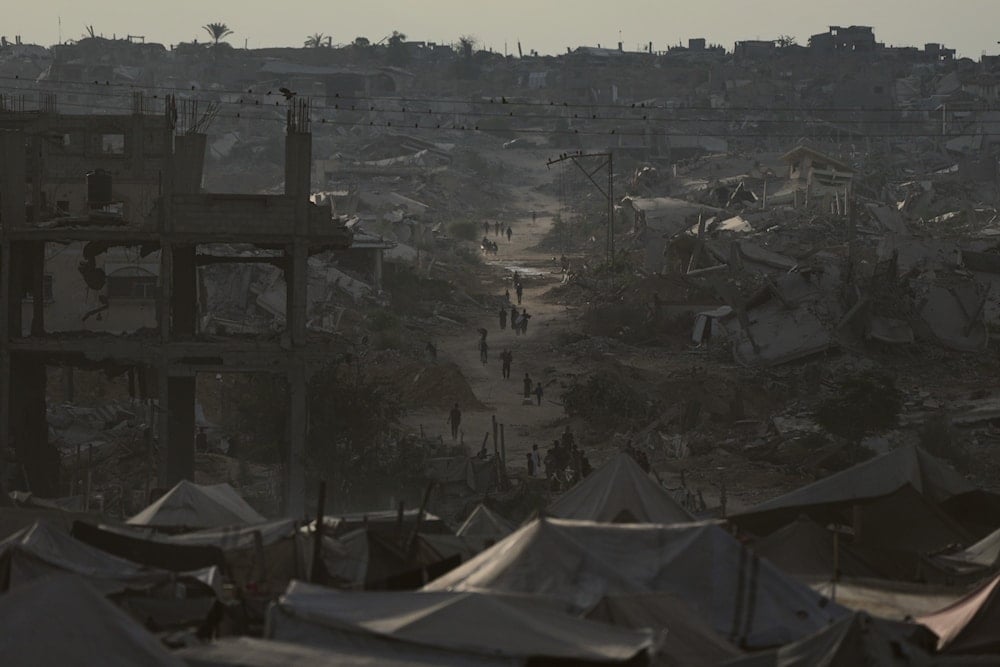Gaza left in environmental freefall after war, report says
Gaza faces an environmental collapse after two years of war, with poisoned water, destroyed croplands, and failing infrastructure threatening recovery.
-

Displaced Palestinians walk through destroyed homes and buildings in Khan Younis, Gaza Strip, on October 18, 2025. (AP Photo/Jehad Alshrafi)
Gaza’s critical infrastructure, water, sanitation, and energy, is on the verge of total collapse after nearly two years of war, according to a new report by the Arava Institute. As residents begin returning following a ceasefire, the report warns that the scale of Gaza's environmental collapse could make recovery impossible without immediate international action.
The report highlights that 69% of the region’s infrastructure has been damaged, placing over two million Palestinians at continued risk of a humanitarian crisis amid widespread environmental destruction.
The Arava Institute report, released on Wednesday, estimates that Gaza infrastructure damage has reached critical levels. With 93% of households facing water insecurity and daily water availability reduced to just 8.4 liters per person, well below the World Health Organization’s emergency threshold of 15 litres, access to clean water has become a central concern.
All wastewater treatment plants have ceased to function, and raw sewage now flows into makeshift lagoons that risk overflowing into homes and seeping into the coastal aquifer, Gaza’s primary source of groundwater. Nearly half of all households report sewage or stagnant water within 10 meters of their shelters, raising the likelihood of disease outbreaks such as cholera.
Electricity generation has also dropped by more than 80%, with power outages lasting up to 22 hours daily. The collapsed power grid has left humanitarian operations reliant on fossil fuel generators, particularly diesel.
Croplands destroyed, water scarce, sewage uncontrolled
The ecological toll has also crippled Gaza’s ability to feed itself. According to satellite imagery cited in the report, approximately 80% of all croplands were either damaged or destroyed by March 2025, and malnutrition rates have surged to 10 times their pre-genocide levels.
“Intensive military activities, such as the movement of heavy machinery, compacts, erodes, and depletes fertile topsoil, making it difficult for vegetation to grow,” the report noted, calling the loss of arable land a “serious detriment” to regional food security.
The report mentioned that the Gaza water crisis is further compounded by the blockade of fishing activities, adding that Israeli maritime restrictions have made fishing “virtually impossible since the onset of the conflict,” with at least 120 fishermen killed and others forced to fish dangerously close to the coast.
Dr. David Lehrer, director of applied environmental diplomacy at the Arava Institute, described the situation as far beyond a humanitarian crisis. "Gaza’s environment is in freefall, poisoned water, ruined croplands, and a shattered power grid are pushing the territory to the brink," said Dr. Lehrer. "What we are witnessing is not just a humanitarian catastrophe but an ecological collapse that threatens the very possibility of recovery."
The Arava Institute report on Gaza outlines a three-phase recovery strategy: absorptive, adaptive, and transformative. The initial phase targets urgent needs such as clean water and emergency shelter. The adaptive phase includes decentralized power and wastewater treatment solutions, while the transformative stage proposes full ecosystem restoration and regional cooperation for managing shared resources.
Technologies already piloted in Gaza include solar-powered microgrids, atmospheric water generators, biofiltration wastewater systems, and GreenCake blocks, which are construction materials made from recycled rubble.
Ceasefire triggers return, but services remain in ruins
Thousands of displaced Palestinians have started to return to what remains of their homes following the ceasefire agreement. While global leaders gathering in Egypt this week welcomed the agreement as a step toward reconstruction, significant questions remain over governance, funding, and the long-term roadmap.
Earlier this year, the World Bank, United Nations, and European Union estimated that rebuilding Gaza would require around $53 billion. Wealthy Arab states are expected to contribute, but environmental recovery remains a secondary concern in many proposals.
Dr. Lehrer warned against sidelining ecological repair in the broader recovery effort: "Waiting for politics to catch up is not an option," he said.
"Recovery must start now, with community-driven solutions that can restore the land, water, and air."

 4 Min Read
4 Min Read








